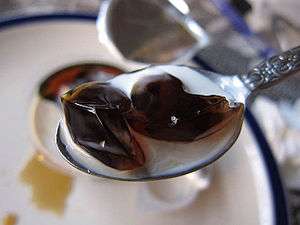Coffee jelly
 | |
| Type | Jelly dessert |
|---|---|
| Place of origin | Japan, England |
| Main ingredients | Instant or fresh coffee, sugar and gelatin or agar jelly |
|
| |
Coffee jelly (コーヒーゼリー kōhī zerī) is a jelly dessert flavored with coffee and sugar. Although once common in British and American cookbooks, it now most common in Japan, where it can be found in most restaurants and convenience stores.
History
Recipes for coffee jelly appear in cookbooks published in England as early as 1817.[1] The earliest recipes call for coffee to be mixed with calves' foot jelly and sometimes call for isinglass or other clarifiers.[2] After the introduction of packaged gelatin, most recipes call for the gelatin to be dissolved in the hot coffee and then molded.[3]
In the early 20th century coffee jelly was promoted as a healthier alternative to hot coffee, as it was thought the gelatin would absorb excess acid in the stomach.[4]
Jell-O launched a short lived coffee gelatin mix in 1918,[5] but the dessert never gained widespread popularity outside of New England. Today, coffee jelly may still be found in Rhode Island, Massachusetts and other New England states. Durgin-Park restaurant in Boston, which opened in 1827, still offers coffee gelatin made with leftover coffee from the previous day.[6]
Japanese coffee jelly was developed during the Taishō period (1912–1926)[7] in imitation of European moulded jellies. It appealed to modern young men with tastes for Western fashion and rose in popularity along with café culture.[7] Coffee jelly has remained popular in Japan and is still widely available. Starbucks launched a coffee jelly frappuccino in Japan in 2016.[8]
Description
Japanese coffee jelly is made from sweetened coffee added to agar, a gelatin-like substance made from algae and called kanten in Japanese.[7] In European and American recipes, traditional gelatin is used rather than agar.
It is often cut into cubes and served in a variety of dessert dishes and beverages. Cubes of coffee jelly are sometimes added to milkshakes, at the bottom of an ice cream float, or to garnish an ice cream sundae. Coffee jelly is often added to a cup of hot or iced coffee, with cream and gum syrup added. Condensed milk is poured over cubes of chilled coffee jelly in a bowl.[9]
Coffee jelly can be made using instant mix or from scratch. It is served in restaurants and cafés, and is sometimes a part of students' lunches served at public schools in Japan.
See also
- List of coffee dishes
-
 Food portal
Food portal
References
- ↑ Hughson, D. (1817). The New Family Receipt Book. London: W. Pritchard and J. Bysh. p. 204. Retrieved 1 September 2016.
- ↑ Jarrin, G.A. (1827). The Italian Confectioner (Third ed.). London: William A. Ainsworth. p. 141. Retrieved 1 September 2016.
- ↑ Kander, Simon (1921). The Settlement Cookbook (Eleventh ed.). Milwuakee: The Settlement Cookbook Company. p. 371. Retrieved 1 September 2016.
- ↑ "Coffee After Dinner". The Lancet: 177. July 18, 1903. Retrieved 1 September 2016.
- ↑ Schlichenmeyer, Terri. "10 Food Products That (Thankfully) Flopped". Mental Floss. Retrieved 1 September 2016.
- ↑ Pandolfi, Keith. "Boston Uncommon". Saveur. Retrieved 1 September 2016.
- 1 2 3 White 2012, p. 123.
- ↑ Chamlee, Virginia. "People Are Going Crazy for Starbucks Japan's Coffee Jelly Frappuccinos". Eater. Retrieved 1 September 2016.
- ↑ Macewan, Matthew. "The Delicious Road: a Japanese Dessert Journey". Tofugu. Retrieved 31 August 2016.
Bibliography
- White, Merry I. (2012). Coffee Life in Japan. University of California Press. ISBN 978-0-520-25933-1.